|
|
|
Observing Snow
IMPORTANT: In order to view this page correctly, you will need to download
the
Navajo font (truetype) and install it on your computer. It's available
as a free download from Diné Education
Web.
|
These two should look alike.
|

|
shr--
|
|
Exploring Native Snow
Terms
With a background in traditional winter lifestyles and
the field exercises conducted with local elders and experts,
we now have a context within which to learn about specific
snow types as recognized locally, especially those types
given specific names in the local native language. Native
terms and concepts are part of a system of knowledge
developed through a relationship with the land and out of
long-term observation. These observations have been shared
among communities and have become an integral part of the
way people communicate with each other. In short, native
snow terminology makes most sense within the stories native
people tell about snow, or in which snow plays a role.
It is commonly stated that Eskimo languages have a great
many words for snow, and the same can be said of Alaskan
Athabascan languages. But this proposition is controversial
and estimates of the number of Eskimo snow terms range from
four into the hundreds. The various estimates result mainly
from different ways of determining what counts as a word.
Eskimo and Athabascan languages are structurally quite
unlike English, which has relatively simple word formation
processes. Words in Alaska Native languages can sometimes
contain ideas that would be expressed as an entire sentence
in English. At the same time, those words are based upon
stem meanings to create large sets of related words. So the
four Eskimo snow terms in one estimate is probably looking
at what English speakers might consider four broad
categories of snow, while the estimate of hundreds of terms
is probably a list of what English speakers would think of
as expressions (sentences) about snow.
When we investigate Native snow terminology, focus should
not be the words themselves, though they are interesting.
Nor should we focus on counting them, though you might find
many. Our concern is with the concepts recognized by local
experts and the significance of those concepts for life in
winter and our understanding of the winter environment.
|
Chapter

|
" When it snow,
snow every day like that, they say
noghedetsitl. Gonna be deep snow. Gonna be
easy to catch moose now, run them down, you know.
Too much snow for the moose. It get too deep snow.
You can catch him up after the snow settles. So
everybody get happy. They gonna have a good
winter.
- Wilson
Titus" |
|
|
Snow
"Snow is tsitl. Just
like if you see if it's snowing now, you'll say e[yoth.
And summer time is e[chonh,
rain. So e[yoth.
Falling snow is yoth. And then when the snow is on
the ground, tsitl. New snow, top snow is
kocheda'. Just like when I tell you about getting the
bottom snow, the top one is kocheda'. Just like right
now, too [November], it's kocheda'.
You don't get no bottom snow because there's not enough snow. When
it's deep and the bottom snow turn to ice, there's little
cube of ice like when you get to that bottom snow. So the
bottom is yeth uga'. That's what we use for water a
long time ago, because it makes more water. It turns to ice,
little ice. You can see it. You get that top snow it's too
light. It don't make much water when you try to melt it. We
just dig all the top snow off like that, and then get the
bottom one, you
know. - Wilson Titus
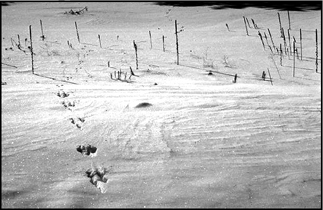 Falling
snow you say e[yoth,
"it's snowing." Big snow they call it gwx tthi chwx.
You know the snow is about this big [large, fluffy
flakes]. E[yoth is
the same thing, but they call it gwx tthi chwx. It
look more like rabbit head, so they call it 'rabbit head
snow'. They call it gwx tthi chwx e[yoth. Falling
snow you say e[yoth,
"it's snowing." Big snow they call it gwx tthi chwx.
You know the snow is about this big [large, fluffy
flakes]. E[yoth is
the same thing, but they call it gwx tthi chwx. It
look more like rabbit head, so they call it 'rabbit head
snow'. They call it gwx tthi chwx e[yoth.
New snow is kocheda'. Tsitl kocheda'.
Little animals they like to travel on that kind of snow.
Like rabbit, chicken, fox, mink. Otter, beaver, things like
that. They go out for something to eat. I don't know why.
Just like us they want to be out in the fresh air. We see
their tracks. And if I go out and I want to catch fox or
rabbit I'll follow it. I'll follow fresh tracks until I
catch up. This time of year, right now [November],
rabbits they stay under, you know. Stay under snow sometime.
And February they come out. And it's easier to catch rabbits
that way. Right now when they come out they go anyplace, you
know. Winter time sometime they make straight trail, where
he go lots. And that's where we go set snare.
- Evelyn Alexander" |
|
Cultural
Standard:
Curriculum
D1
draws parallels
between
knowledge
derived from
oral tradition
and
that derived
from books
|
Discussion
- Identify some basic distinctions the Minto Elders
make in describing snow. (Hint: "rabbit head snow" is not
a basic term, but is an expansion of "snow").
- Under what conditions does "rabbit head" snow
form? (Refer to the graph on page 28.)
- Refer to the Athabascan Snow Terminology table
on the facing page and try to identify more basic distinctions.
Do you see words that look related across languages?
(See, for example "sled" which, despite the different
spelling systems, sounds nearly the same in all three
languages)
- Can you relate Athabascan snow types to the processes
you investigated in the snow pit exercise?
|
|
Athabascan Snow Terminology
(examples)
|
Snow Type
|
Tanana: Minto
|
Koyukon
|
Gwich'in
|
|
snow
|
tsitl
|
tseetl
|
zhah
|
|
falling snow
|
yoth
|
yo[ |
|
|
"it's snowing"
|
e[yoth |
e[yo[ |
ahshii
|
|
powder or new snow
|
kocheda'
|
|
chat
|
|
snowflake
|
tseetl zrax
|
|
zhah tsuu
|
|
hard snow
|
|
tseetl tl'ene'
|
tsi[ |
|
dry snow
|
tsitl naga'
|
|
|
|
wet snow
|
tsitl tr'ela
|
yo[
tlugge' |
da'ant[oh |
|
blowing snow
|
tsitl
e[choyh |
mek'oodaats'eeye
|
tsi[
hàat[it |
|
wind
|
e[tr'eyh |
tets'eeyh
|
ahtr'aii
|
|
snow drift
|
tsitl kat'ena
|
menedaalts'eyh
|
zhah khàdk'at
|
|
snow on tree branches
|
dwx tsidla'
|
duhtseedle'
|
deh zhàa
|
|
frost
|
srwx
|
suh
|
shr-- |
|
falling frost
|
tsitl done'
|
k'ekk'utl done'
|
|
|
ice crusted snow
|
xwlu
|
tleehuloo
|
gwiluu
|
|
depth hoar, bottom snow
|
yeth uga'
|
[eyh
|
tsaih ghyàa
|
|
snow water
|
tsitl tu
|
tokaas
|
|
|
ice
|
[ut |
[oo |
[uu
|
|
river/lake ice
|
tenh
|
tehn
|
tan
|
|
slush
|
zrax
|
noozaah
|
|
|
overflow ice
|
nolgat
|
ggeetl
|
|
|
overflow (water)
|
tenh ko tu'
|
tenh kontoo'
|
|
|
glacier
|
get [u |
[oo se[ |
git
|
|
winter trail
|
xwyh tena
|
|
chuuluu
|
|
snowshoes
|
oyh
|
oyh
|
aih
|
|
sled
|
xwtl
|
hutl
|
kha[ |
|
|
Snow Water
"Tsitle tu' means
snow water. We taught the kids to dig to the bottom to get
the snow there, yeth uga', bottom snow. Kind of
little bigger than the top snow. You fill up bucket like
this, the water will be this much for the top snow. But if
you get bottom snow the water will be almost full. More
water come out of the bottom snow. Anyway they used to say
clear water, cleaner than top snow.
All winter we use snow water. Springtime come we use
water, but sometimes we go around in canoe we look for snow
drift. We get snow. We save it for drinking water until no
more snow, until in June. Sometimes late June. Out in camp,
we stay out in camp. They make cellar, and they keep snow in
cellar. Tanana River, when ice move we put ice to shore. We
cut them up and haul them back to our house. Most of the
people used to have cellar. We keep ice there.[ut.
[ut tso k'a drighila means ice cellar.
Sometime when the water come it's a little bit muddy, you
know. Lots of little grass, gotta settle them. Lots of
little bugs sometimes. We have to boil them and settle it. I
haven't seen that for a long time. We don't do that no more.
If I move I'll take that snow, maybe I'll save ice. We get
ice too. Clear water. Snow water, tsitl tu'. We use
that for tea, and drinking. It tastes better than well
water.
- Evelyn Alexander
There's a different name for ice, tenh.
Tenh means it's down there in the creek, you know.
That ice down there in the creek. Another kind of ice, you
bring chunk of ice up they call that [ut.
Ice down there on the lake [or creek] is
tenh. Chunk of ice you bring up that's [ut.
We got two different names for it, two different kinds.
Sometimes you use [ut for drinking water, sometimes snow, yeth uga'. You
got nice clear water, anyway.
- Wilson Titus" |
Discussion
- What are the advantages of "snow water"?
- What physical process creates "bottom snow"? What do
scientists call this type of snow?
- Why do you think Minto Elders distinguish two types of ice?
What does this suggest about traditional ways of classifying
things?
- Are people in your community concerned about potential
contamination of snow from environmental pollutants?
|
Snow in Trees
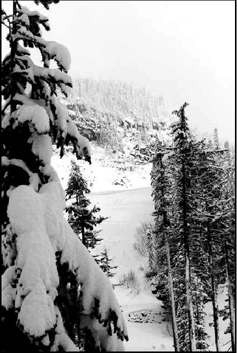 "Snow
in the trees is dwxtsidla'. Dwx means up high.
You go up the Washington in the winter it's just like
Fairbanks, no wind up there. All the snow on the brush. You
see, when you see lot's of dwxtsidla' it makes good
hunting. The sound don't move. It don't make no sound when
you walk and break little twigs. Because you gotta stay
pretty quiet when you tracking moose, you know. Because he's
gonna hear you before you see him. That's why I say they
were good hunters. Hunters they know just how to sneak for
moose. And they get 'em every time. Before moose lay down,
too, they go around downwind. They go around in circle.
Sometimes they can see their track and know where they went.
They watch all the time. They watch for wolves and
everything. The good hunters they turn off the track. And
come to this [downwind] side where they can't smell
you all the time. Because they'll smell you every time.
Little breeze, that's why. They circle around before they
lay down. Even no wind like this, you get that light snow
that kocheda'. They throw it up, they know which way
that breeze blows, the way that snow blows. When they're
tracking moose, then they know which way to go. "Snow
in the trees is dwxtsidla'. Dwx means up high.
You go up the Washington in the winter it's just like
Fairbanks, no wind up there. All the snow on the brush. You
see, when you see lot's of dwxtsidla' it makes good
hunting. The sound don't move. It don't make no sound when
you walk and break little twigs. Because you gotta stay
pretty quiet when you tracking moose, you know. Because he's
gonna hear you before you see him. That's why I say they
were good hunters. Hunters they know just how to sneak for
moose. And they get 'em every time. Before moose lay down,
too, they go around downwind. They go around in circle.
Sometimes they can see their track and know where they went.
They watch all the time. They watch for wolves and
everything. The good hunters they turn off the track. And
come to this [downwind] side where they can't smell
you all the time. Because they'll smell you every time.
Little breeze, that's why. They circle around before they
lay down. Even no wind like this, you get that light snow
that kocheda'. They throw it up, they know which way
that breeze blows, the way that snow blows. When they're
tracking moose, then they know which way to go.
- Wilson Titus
Yeah, dwxtsidla' means snow on the brush, on the
trees, or on the stump, or stuff like that.
Dwxtsidla', that's what we call it. I can tell you
one thing about that dwxtsidla', it's no good to walk
in there. Just get down your neck all the time. Especially
at marten trapping time. Wet your gloves, maybe wet the back
of you if it's warm enough.
- Neal Charlie"
|
Note
The Koyukon Athabascan Dictionary (Jette and Jones 2000) lists
duxtseedla', "snow on trees," and notes that it undergoes
melt-freeze metamorphism on the branches and can be eaten for
moisture, while powdery snow only increases thirst.
Discussion
- Have you noticed snow in the trees? What's good and not so
good about that condition?
- Look at dwxtsidla' through a hand lens. What kind of
crystals do you see?
- Draw a diagram (on paper or the board) of the moose tracking
technique described by Wilson Titus.
|
Snow Drifts
" Snow drift is tsitl
kat'ena. If the snow is high enough you can make a
shelter in there for one thing. And another thing is that
when we used to snowshoe all day, we take our snowshoe off,
and we walk on that tsitl kat'ena. Just like walking
on trail. That way we don't have to make trail on snowshoe,
so that's two good thing there. Them Eskimos, I hear over in
their country they follow that snow drift, and they know
which direction that snow drift just lead them. Just like
trees to us. Trees is what we follow. If I was gonna go out
this way, I'll see a tree out there, and maybe I'll just go
by that tree mostly. Or like island with birch on there,
something like that.
- Neal Charlie
Wind blown snow is tsitl
enitr'eda[tr'eyhti.
So when the snow blows it piles up by the woods, that means
that tsitl enitr'eda[tr'eyhti,
when it pile up. Tsitl enitr'eda[tr'eyhti means
it just blow, just like out on the lake. When it hit the brush it just
pile up, snowdrift. That's what makes a
snowdrift. Tsitl kat'ena you call that. Tsitl
kat'ena means hard snow, you walk right on top. When
it's building up they call it tsitl
enitr'eda[tr'eyhti.
It's blowing into one place, blow clean across the lake. We
use it in spring to melt, you know, melt that in bucket. For
water, nice cool, clear water. Like you make tea you want
snow water tea, clear snow water. Nice, clear, snow water
tea.
Wind is e[tr'eyh.
There's this windy place right there, come down from that
creek, from that Ptarmigan Hill. That valley down this way,
come right down there. It's just smokey down there in that
creek. Snow blowing, so they call it Tredhk'oni No'.
Just like it's burning, that's why they call it that.
- Wilson Titus"
|
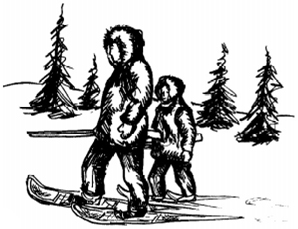
Discussion
- How do snow drifts form? Where do they form?
- Could you tell direction from the orientation of snow drifts
in your area? Why does this work in some places and not in
others?
- Are traditional place names always strictly practical?
|
Deep Snow
"Hard, frozen snow is
xwlu. Xwlu means, like in winter it's wet
snow, you know. And it freeze up like, and it's hard. Then
on top, it snow on top of it. Snow about this much maybe. It
stay like that. And deep snow it used to be hard for moose.
Easy to catch moose, because it's hard to step through.
- Evelyn Alexander
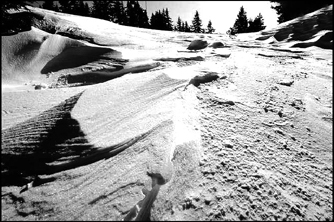 So
when it snows a lot, every day, the snow is getting deep.
They call that noghedetsitl. It snow day and night.
Detsitl means snow, you know. That means we're gonna
have a lot of snow, deep snow. That's the most snow I seen
in my life, 1937. Snowed, snowed, every day. Me and this guy
I was talking about, we went way up the Tatalina
[River], walking while the snow was still soft yet.
Took us three days to walk out [there]. While we was
up there we had nothing to eat, ran out of groceries. We
went after moose during that soft snow, snow that deep. Sink
right down in the snow that moose. We caught him up. So
when it snows a lot, every day, the snow is getting deep.
They call that noghedetsitl. It snow day and night.
Detsitl means snow, you know. That means we're gonna
have a lot of snow, deep snow. That's the most snow I seen
in my life, 1937. Snowed, snowed, every day. Me and this guy
I was talking about, we went way up the Tatalina
[River], walking while the snow was still soft yet.
Took us three days to walk out [there]. While we was
up there we had nothing to eat, ran out of groceries. We
went after moose during that soft snow, snow that deep. Sink
right down in the snow that moose. We caught him up.
While we was out there it rain, you know. Quarter inch,
half an inch. Crust. It cleared up. Just cleared up and then
it snowed 3 inches more, 4 inches more. On that soft snow,
you just go right on top, drive dog team. Those poor moose
had a hard time. They had to break that crust too, you know.
They just stay in one place. Place where it could eat, you
know. Where they could eat. Just go back and forth.
[You call that crust] xwlu. On top of the
snow they call it xwlu, yeah. You need snow on top, you
know. Otherwise you can't walk with snow shoe, you know.
It's too slippery.
- Wilson Titus" |
Discussion
- Discuss the consequences of light snow seasons and heavy snow
seasons.
- What is the average annual snowfall in your area?
- How does snowfall affect animal populations? (Think about
large and small animals.)
|
Spring Snow
"Nezrax, that's in
spring time. It's heavy and it makes more water. No good to
walk in though, no good to walk in. They used to just travel
at nights when that kind of slushy snow start. Slushy snow
that's nezrax. In the evening when it freeze, when
the snow freeze, we call that noxuthdetenh. They test
it. In the evening they test it. They throw a big stick over
on the snow. If it land on the snow and don't bust through
that means it's time to go.
- Neal Charlie
Nezrax. That means it soften up - the snow, you
know. You don't travel on that. Don't travel on
nezrax. Wait until noxuthdetenh. It freeze up,
then you go. It's not good for walking on that soft snow.
Your snow shoe gets heavy. It just stick to those snowshoes.
You have to take a stick knock it off. Nezrax. No
good for your babiche [raw hide snowshoe webbing].
Your babiche get all wet and you step right through. My
father used to use willow. He get willows and he split them.
Never loosen up, stay tight all the time. Babiche is no good
for spring time. It get's wet and pretty soon you just step
right through. That's why they use willow all the time. My
dad used it, I saw him. Black ones they use. He splits it
just like string or twine. He don't put it through the holes
he put it right around the frame.
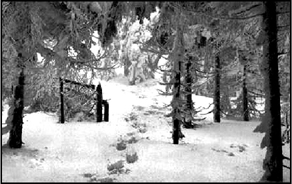 In
the spring time it melts and freezes and the top is icy,
noxuthdetenh. In springtime when snow is soft you
just gotta travel when noxuthdetenh. You gotta start
out in the evening. It's too soft for your sled. People
travel at night. Just like when I say you move out and you
move back. From way out you're moving back, you do it
nighttime. Maybe four o'clock in the morning. Sleep all day,
you know. Just keep moving nighttime. In
the spring time it melts and freezes and the top is icy,
noxuthdetenh. In springtime when snow is soft you
just gotta travel when noxuthdetenh. You gotta start
out in the evening. It's too soft for your sled. People
travel at night. Just like when I say you move out and you
move back. From way out you're moving back, you do it
nighttime. Maybe four o'clock in the morning. Sleep all day,
you know. Just keep moving nighttime.
You can hunt in that snow with dogs when it freeze up
good. You turn them dogs loose and they find moose right
away. The dogs stay on top. Those dogs catch him. He just
stand there and turn around. He don't start running by the
time you get there. Good hunters, them dogs. Real good
hunters. They just go like that right in front of him. Dogs
too they learn, too. I know a good hunting dog, train them
you know. They don't care for bears, though. You go near
bear den, they don't want to bother with it.
- Wilson Titus" |
Discussion:
- Discuss the challenges and advantages of spring snow.
- What kinds of technology allowed people to survive in the
winter?
- How did native people use dogs in winter? How has that changed
over time? How do people use dogs today?
|
Travel
Conditions
"Really light snow, that
really soft snow, light. That's good for traveling. Like
when you travel with dog team light snow on the trail. Warm
weather kind of wet snow is hard pulling, because it sticks
to the bottom and ice up. Runners heat up, I guess, and the
runner ice up. Once in a while you stop and scrape the ice
off like that. Cold weather hardly don't do that.
- Wilson Titus
You walk today and you make a trail. Today it'll be soft
but tomorrow it'll be good to walk on. Yet you still use
snowshoes, though. Twx xwlu. Tena twx xwlu,
means a little bit hard. Tena is trail. Tena twx
xwlu xulanh means it's hard now, time to move. But we
stay in one camp if they catch one or two moose. They stay
there until the women get through with moose skin. Take two
days, three days sometimes.
When we move, and they shovel snow where we gonna put up
tent, they always say tsitl naga'. Means soft snow,
easy to shovel. Sometimes we shovel snow on berries. We use
snowshoes lots when it's like that, like right now [thin
snowcover]. That's not because it's deep but it's good
to walk through niggerhead [tussocks]. Snowshoes.
Praise the lord.
- Evelyn Alexander" |
|
Activity: Documenting
Local Snow Terms
Ask Elders to teach you about snow terms.
Time: 2-3 hours
Materials: Voice recorder and tape
- A good place to start this discussion is
during the snow pit exercise conducted in
Chapter 4. Invite Elders to observe and to offer
their comments afterward. The better they
understand our learning objectives, the better
they'll be able to address the topics.
- Continue the discussion in small groups,
perhaps 2-4 students with an Elder is ideal.
Find a quiet location where Elders and students
are comfortable.
- Listen first to the Elder's stories. When
they make a long pause or ask for questions, you
may ask about specifics.
- Use a tape recorder if the Elders and
students are comfortable with this. It is better
to listen attentively during the discussion and
take notes later.
- Depending on the students' familiarity with
the local native language and writing system,
the assistance of your Bilingual Program Teacher
or other adult literate in the local language
may be necessary to get the native terminology
transcribed accurately.
- Record local terms and observations in the
Snow Journal on page 9. Where possible, try to
guess the snow crystal types which might be
associated with each kind of snow.
|
|
CS
Curriculum
C1
utilizes the
local language,
local cultural
knowledge |
|
CS
Students
B2
use of
knowledge,
skills and ways
of knowing to
learn about the
larger world |
Glossary of Snow Terms
found in "Observing Snow"
Lower Tanan Athabascan (Minto)
General
tsitl - snow
yoth - falling snow
e[yoth -
"it's snowing"
ghi[yoth
- "it snowed"
kocheda' - new snow, soft snow, surface snow
tsitl kocheda'- new snow, soft snow, surface snow
tsitl zrax - snowflake
tsitl naga' - dry snow
yoth naga' - dry falling snow
yoth tre[-
wet snow, falling
tsitl trela' - wet snow
tsitl naga' e[yoth
- "it's snowing dry snow"
gwx tthi chwx - rabbit head snow (large fluffy flakes)
gwx tthi chwx e[yoth
- it's snowing rabbit heads
nezrax - slush
e[tr'eyh -
"wind blows"
tsitl e[choyh
- blowing snow
tsitl enitre'da[tr'eyhti
- "wind-blown snow
tseetl kat'ena - snow drift
srwx - frost
tsitl done' - falling frost
tsitl kat'ena srwx xulanh - "there's frost on the
snowdrifts"
dwx tsidla' - snow on trees
Snow Water
yeth uga' - bottom snow, depth hoar
tsitl tu - snow water
Trail and Travel Conditions
xwlu - ice crusted snow
twx xwlu - frozen surface
tena - trail
tena twx xwlu - hard trail
tena twx xwlu xulanh - there's a hard surface on the trail
xwyh tena - winter trail
tenh ko tu' - overflow
nolgat - overflow ice, glaciering, aufeis
ethdetenh - frozen up
noxuthdetenh - frozen crust
noghedetsitl - deep snow
Ice
tenh - ice on a river or lake
[ut -
ice in
chunks
[ut tso
k'a *drighila - ice cellar (*uncertain spelling)
Miscellaneous
delozragi - wood shavings
oyh - snowshoes
xwtl - sled
do'int'a - greetings
hwtlani - not good, forbidden, taboo
xo'iltanh - take care of yourself (be clean)
k'onaniltayh - take care, be careful
Seasons
xwyhts'en' - fall
xwyh - winter
D5y' -
spring
sanh - summer
Benenh Taxuk'odhi - November
Place Names
Benok'oget - North Fork, ridge near new Minto
Dwxtso Dedhdlode - Cache
Tthi'tu' - Tanana River
Menhti Xwghotthit - Old Minto
Teyh Tethde - Lake Minto Portage
K'athnodadelenh No' - West Fork Camp
Xoxwnghodeghesrdenh - Montana Creek / fall camp
Mentoli Chaget - Birch Hill
Tredhk'oni No' - blowing snow/smokey creek below Ptarmigan
Hill
Tthayi Chaget - tributary creek of the Tatlanina
Ch'etoch'o No' - Tolovana River
Tolbo No' - Lower Tolovana River
Tat'ali No' - Middle Washington Creek
Dradlaya Nik'a - Chatanika River
Toltthwgha Nik'a - Goldstream Creek
Xwdodli Nik'a - Big Goldstream Creek
Menhti Xwno' - Minto Slough
Notes:
Observing Snow
Introduction
The Four Corners of Life
Water: the Stuff that Makes Snowflakes
Snow on the Ground Changes Through Time
Exploring Native Snow Terms
Glacier Investigations
Open Note Review
Conclusion
Bibliography & Resources
|
 The
University of Alaska Fairbanks is an Affirmative
Action/Equal Opportunity employer, educational
institution, and provider is a part of the University of Alaska
system. Learn more about UA's notice of nondiscrimination. The
University of Alaska Fairbanks is an Affirmative
Action/Equal Opportunity employer, educational
institution, and provider is a part of the University of Alaska
system. Learn more about UA's notice of nondiscrimination.
Alaska Native Knowledge
Network
University of Alaska Fairbanks
PO Box 756730
Fairbanks AK 99775-6730
Phone (907) 474.1902
Fax (907) 474.1957 |
Questions or comments?
Contact ANKN |
|
Last
modified
August 17, 2006
|
|
|